大学化工专业英语Lesson 1
- 格式:doc
- 大小:45.50 KB
- 文档页数:5
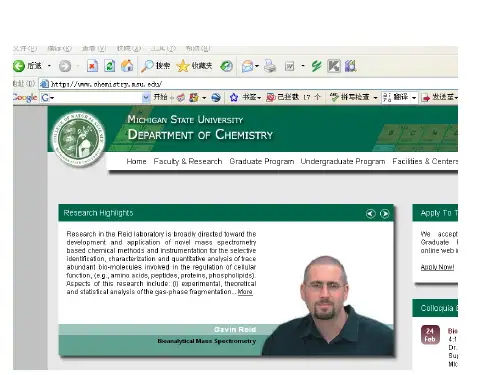
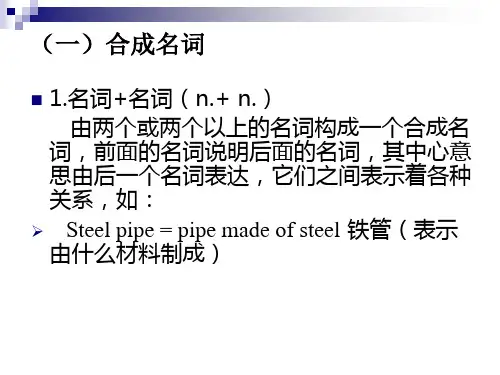

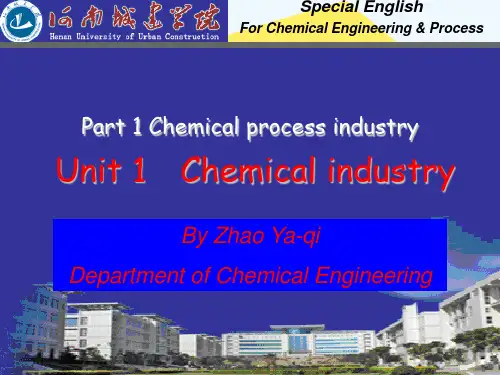
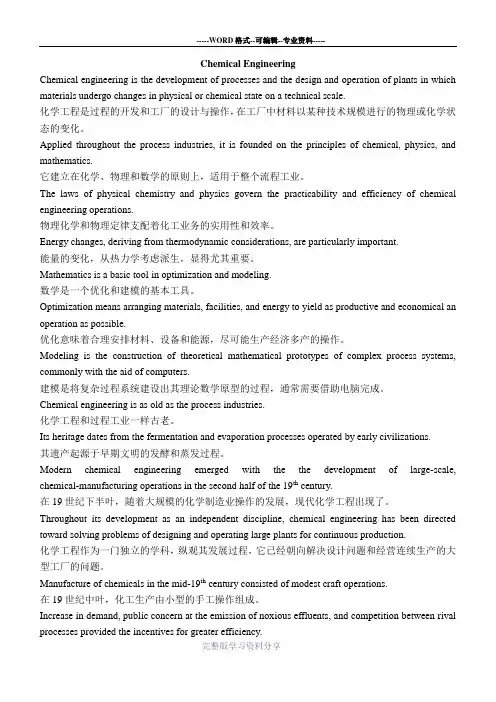
Chemical EngineeringChemical engineering is the development of processes and the design and operation of plants in which materials undergo changes in physical or chemical state on a technical scale.化学工程是过程的开发和工厂的设计与操作,在工厂中材料以某种技术规模进行的物理或化学状态的变化。
Applied throughout the process industries, it is founded on the principles of chemical, physics, and mathematics.它建立在化学、物理和数学的原则上,适用于整个流程工业。
The laws of physical chemistry and physics govern the practicability and efficiency of chemical engineering operations.物理化学和物理定律支配着化工业务的实用性和效率。
Energy changes, deriving from thermodynamic considerations, are particularly important.能量的变化,从热力学考虑派生,显得尤其重要。
Mathematics is a basic tool in optimization and modeling.数学是一个优化和建模的基本工具。
Optimization means arranging materials, facilities, and energy to yield as productive and economical an operation as possible.优化意味着合理安排材料、设备和能源,尽可能生产经济多产的操作。
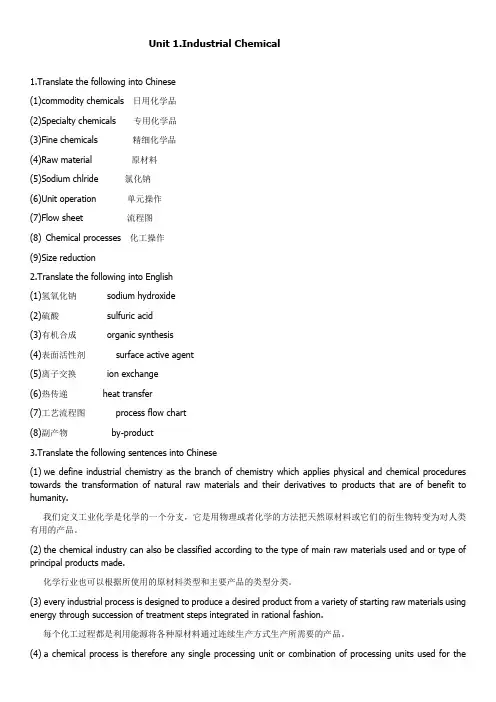
Unit 1.Industrial Chemical1.Translate the following into Chinese(1)commodity chemicals 日用化学品(2)Specialty chemicals 专用化学品(3)Fine chemicals 精细化学品(4)Raw material 原材料(5)Sodium chlride 氯化钠(6)Unit operation 单元操作(7)Flow sheet 流程图(8) Chemical processes 化工操作(9)Size reduction2.Translate the following into English(1)氢氧化钠sodium hydroxide(2)硫酸sulfuric acid(3)有机合成organic synthesis(4)表面活性剂surface active agent(5)离子交换ion exchange(6)热传递heat transfer(7)工艺流程图process flow chart(8)副产物by-product3.Translate the following sentences into Chinese(1)we define industrial chemistry as the branch of chemistry which applies physical and chemical procedures towards the transformation of natural raw materials and their derivatives to products that are of benefit to humanity.我们定义工业化学是化学的一个分支,它是用物理或者化学的方法把天然原材料或它们的衍生物转变为对人类有用的产品。
(2)the chemical industry can also be classified according to the type of main raw materials used and or type of principal products made.化学行业也可以根据所使用的原材料类型和主要产品的类型分类。

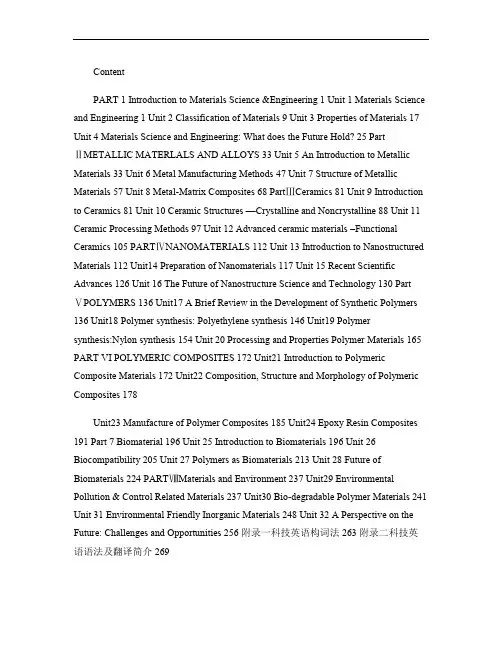
ContentPART 1 Introduction to Materials Science &Engineering 1 Unit 1 Materials Science and Engineering 1 Unit 2 Classification of Materials 9 Unit 3 Properties of Materials 17 Unit 4 Materials Science and Engineering: What does the Future Hold? 25 PartⅡMETALLIC MATERLALS AND ALLOYS 33 Unit 5 An Introduction to Metallic Materials 33 Unit 6 Metal Manufacturing Methods 47 Unit 7 Structure of Metallic Materials 57 Unit 8 Metal-Matrix Composites 68 PartⅢCeramics 81 Unit 9 Introduction to Ceramics 81 Unit 10 Ceramic Structures —Crystalline and Noncrystalline 88 Unit 11 Ceramic Processing Methods 97 Unit 12 Advanced ceramic materials –Functional Ceramics 105 PARTⅣNANOMATERIALS 112 Unit 13 Introduction to Nanostructured Materials 112 Unit14 Preparation of Nanomaterials 117 Unit 15 Recent Scientific Advances 126 Unit 16 The Future of Nanostructure Science and Technology 130 PartⅤPOLYMERS 136 Unit17 A Brief Review in the Development of Synthetic Polymers 136 Unit18 Polymer synthesis: Polyethylene synthesis 146 Unit19 Polymer synthesis:Nylon synthesis 154 Unit 20 Processing and Properties Polymer Materials 165 PART VI POLYMERIC COMPOSITES 172 Unit21 Introduction to Polymeric Composite Materials 172 Unit22 Composition, Structure and Morphology of Polymeric Composites 178Unit23 Manufacture of Polymer Composites 185 Unit24 Epoxy Resin Composites 191 Part 7 Biomaterial 196 Unit 25 Introduction to Biomaterials 196 Unit 26 Biocompatibility 205 Unit 27 Polymers as Biomaterials 213 Unit 28 Future of Biomaterials 224 PARTⅧMaterials and Environment 237 Unit29 Environmental Pollution & Control Related Materials 237 Unit30 Bio-degradable Polymer Materials 241 Unit 31 Environmental Friendly Inorganic Materials 248 Unit 32 A Perspective on the Future: Challenges and Opportunities 256 附录一科技英语构词法263 附录二科技英语语法及翻译简介269附录三:聚合物英缩写、全名、中文名对照表280 附录四:练习题参考答案284 PART 1 Introduction to Materials Science &EngineeringUnit 1Materials Science and Engineering Historical PerspectiveMaterials are probably more deep-seated in our culture than most of us realize. Transportation, housing, clothing, communication, recreation, and food production —virtually every segment of our everyday lives is influenced to one degree or another by materials. Historically, the development and advancement of societies ha ve been intimately tied to the members‘ ability to produce and manipulate materi- als to fill their needs. In fact, early civilizations have been designated by the level of their materials development (Stone Age, Bronze Age, Iron Age.The earliest humans had access to only a very limited number of materials, those that occur naturally: stone, wood, clay, skins, and so on. With time they discovered techniques for producing materials that had properties superior to those of the natural ones; these new materials included pottery and various metals. Furthermore, it was discovered that the properties of a material could be altered by heat treatments and by the addition of other substances. At this point, materials utilization was totally a selection process that involved deciding from a given, rather limited set of materials the one best suited for an application by virtue of its characteristics.①It was not until relatively recent times that scientists came to understand the relationships between the structural elements of materials and their properties. This knowledge, acquired over approximately the past 100 years, has empowered them to fashion, to a large degree, the characteristics of materials. Thus, tens of thousands of different materials have evolved with rather specialized charac- teristics that meet the needs of our modern and complex society; these include metals, plastics, glasses, and fibers. deep-seated根深蒂固的, 深层的pottery / ☐☯❑♓陶器structural elements结构成分;property / ☐❑☐☜♦♓/⏹.性能The development of many technologies that make our existence so comfortable has been intimately associated with the accessibility of suitable materials. An advancement in the understanding of a material type is often the forerunner to the stepwise progression of a technology. For example, automobiles would not havebeen possibl- e without the availability of inexpensive steel or some other comparable substitute. In our contemporary era, sophisticated electronic devices rely on components that are made from what are called semiconducting materials. Materials Science and EngineeringThe discipline of materials science involves investigating the relationships that exist between the structures and properties of materials. In contrast, materials engineering is, on the basis of these structure–property correlations, designing or engineering the structure of a material to produce a predetermined set of properties.―Structure‘‘ is at this point a nebulous term that deserves some explanation. In brief, the structure of a material usually relates to the arrangement of its internal components. Subatomic structure involves electrons within the individual atoms and interactions with their nuclei. On an atomic level, structure encompasses the organization of atoms or molecules relative to one another. The next larger structural realm, which contains large groups of atoms that are normally agglomerated together, is termed‗‗microscopic,‘‘ meaning that which is subject to direct observation using some type of microscope. Finally, structural elements that may be viewed with the naked eye are termed ‗‗macroscopic.‘‘The notion of ‗‗property‘‘ deserves elaboration. While in service use, all materials are exposed to external stimuli that evoke some type of response. For example, aspecimen subjected to forces will experience deformation; or a polished metal surface will reflect light. Property is a material trait in terms of the kind and magnitude of response to a specific imposed stimulus. Generally, definitions of properties are made independent of material shape and size.Virtually all important properties of solid materials may be grouped into six different categories: mechanical, electrical, thermal, magnetic, optical, and stepwise /♦♦♏☐♦♋♓/ ♎逐步的sophisticated/♦☯♐♓♦♦♓♏♓♦♓♎/ ♎精制的,复杂的; semiconducting materials 半导体材料nebulous/ ⏹♏♌✞●☯♦/♎含糊的,有歧义的subatomic/ ♦✈♌☯❍♎亚原子的microscopic/❍♓❑☯☐♓♎微观的❍♋♍❑☐♦♍☐☐♓♍/❍✌❑☯✞☐♓♎宏观的deteriorative. For each there is a characteristic type of stimulus capable of provokingdifferent responses. Mechanical properties relate deformation to an applied load or force; examples include elastic modulus and strength. For electrical properties, such as electrical conductivity and dielectric constant, the stimulus is an electric field. The thermal behavior of solids can be represented in terms of heat capacity and thermalconductivity. Magnetic properties demonstrate the response of a material to the application of a magnetic field. For optical properties, the stimulus is electro- magnetic or light radiation; index of refraction and reflectivity are representative optical properties. Finally, deteriorative characteristics indicate the chemical reactivity of materials.In addition to structure and properties, two other important components are involved in the science and engineering of materials, viz. ‗‗processing‘‘ and‗‗performance.‘‘ With regard to the relationships of these four components, the structure of a material will depend on how it is processed. Furthermore, a material‘s perf ormance will be a function of its properties.Fig. 1.1 Photograph showing the light transmittance of three aluminum oxide specimens. From left to right: single crystal material (sapphire, which is transparent;a polycrystalline and fully dense (nonporous material, which is translucent; and a polycrystalline material that contains approximately 5% porosity, which is opaque. (Specimen preparation, P. A. Lessing; photography by J. Telford.We now present an example of these processing-structure-properties-perfor- mance principles with Figure 1.1, a photograph showing three thin disk specimens placed over some printed matter. It is obvious that the optical properties (i.e., the deformation/♎♓♐❍♏♓☞☯变形deteriorative/♎♓♓☯❑♓☯❑♏♓♦♓破坏(老化的elastic modulus 弹性模量strength /♦♦❑♏⏹♑强度;dielectric constant介电常数;heat capacity 热容量refraction/❑♓♐❑✌☞☯折射率; reflectivity/ ❑♓♐●♏♓♓♦♓/ 反射率processing/☐❑☯◆♏♦♓☠加工light transmittance of each of the three materials are different; the one on the left is transparent (i.e., virtually all of the reflected light passes through it, whereas the disks in the center and on the right are, respectively, translucent and opaque.All of these specimens are of the same material, aluminum oxide, but the leftmost one is what we call a single crystal—that is, it is highly perfect—which gives rise to its transparency. The center one is composed of numerous and verysmall single crystals that are all connected; the boundaries between these small crystals scatter a portion of the light reflected from the printed page, which makes this material optically translucent.②And finally, the specimen on the right is composed not only of many small, interconnected crystals, but also of a large number of very small pores or void spaces. These pores also effectively scatter the reflected light and render this material opaque.Thus, the structures of these three specimens are different in terms of crystal boundaries and pores, which affect the optical transmittance properties. Furthermore, each material was produced using a different processing technique. And, of course, if optical transmittance is an important parameter relative to the ultimate in-service application, the performance of each material will be different.Why Study Materials science and Engineering?Why do we study materials? Many an applied scientist or engineer, whether mechanical, civil, chemical, or electrical, will at one time or another be exposed to a design problem involving materials. Examples might include a transmission gear, the superstructure for a building, an oil refinery component, or an integrated circuit chip. Ofcourse, materials scientists and engineers are specialists who are totally involved in the investigation and design of materials.Many times, a materials problem is one of selecting the right material from the many thousands that are available. There are several criteria on which the final decision is normally based. First of all, the in-service conditions must be charac- terized, for these will dictate the properties required of the material. On only rare occasions does a material possess the maximum or ideal combination of properties. transmittance/♦❑✌❍♓♦☜⏹♦/ ⏹. 透射性sapphire /♦✌♐♓☯蓝宝石transparent/♦❑✌☐☪☯❑☯⏹♦/ ♎透明的;polycrystalline/ ☐♓❑♓♦♦☯♓多晶体; translucent/♦❑✌✞♎半透明的; opaque☯✞☐♏♓♎不透明的single crystal 单晶体Thus, it may be necessary to trade off one characteristic for another. The classic example involves strength and ductility; normally, a material having a high strength will have only a limited ductility. In such cases a reasonable compromise between two or more properties may be necessary.A second selection consideration is any deterioration of material properties that may occur during service operation. For example, significant reductions in mecha- nical strength may result from exposure to elevated temperatures or corrosive envir- onments.Finally, probably the overriding consideration is that of economics: What will the finished product cost? A material may be found that has the ideal set of proper- ties but is prohibitively expensive. Here again, some compromise is inevitable.The cost of a finished piece also includes any expense incurred during fabrication to produce the desired shape. The more familiar an engineer or scientist is with the various characteristics and structure–property relationships, as well as processing techniques of materials, the more proficient and confident he or she will be to make judicious materials choices based on these criteria.③Reference:William D. Callister, Materials science and engineering : anintroduction, Press:John Wiley & Sons, Inc.,2007;2-5 transmission gear传动齿轮dictate/♎♓♏♓决定trade off 权衡;折衷ductility♎✈♓●♓♦♓延展性/ ☯✞☯❑♋♓♎♓☠/♎最主要的judicious/♎✞✞♎♓☞☯♦/♎明智的Notes1.At this point, materials utilization was totally a selection process that involved deciding froma given, rather limited set of materials the one best suited for an application by virtue of itscharacteristics由此看来,材料的使用完全就是一个选择过程,且此过程又是根据材料的性质从许多的而不是非有限的材料中选择一种最适于某种用途的材料。
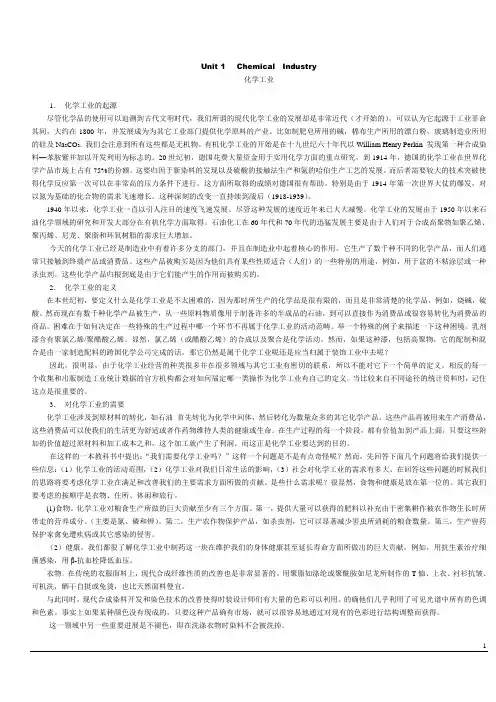
Unit 1 Chemical Industry化学工业1.化学工业的起源尽管化学品的使用可以追溯到古代文明时代,我们所谓的现代化学工业的发展却是非常近代(才开始的)。
可以认为它起源于工业革命其间,大约在1800年,并发展成为为其它工业部门提供化学原料的产业。
比如制肥皂所用的碱,棉布生产所用的漂白粉,玻璃制造业所用的硅及Na2CO3. 我们会注意到所有这些都是无机物。
有机化学工业的开始是在十九世纪六十年代以William Henry Perkin 发现第一种合成染料—苯胺紫并加以开发利用为标志的。
20世纪初,德国花费大量资金用于实用化学方面的重点研究,到1914年,德国的化学工业在世界化学产品市场上占有75%的份额。
这要归因于新染料的发现以及硫酸的接触法生产和氨的哈伯生产工艺的发展。
而后者需要较大的技术突破使得化学反应第一次可以在非常高的压力条件下进行。
这方面所取得的成绩对德国很有帮助。
特别是由于1914年第一次世界大仗的爆发,对以氮为基础的化合物的需求飞速增长。
这种深刻的改变一直持续到战后(1918-1939)。
1940年以来,化学工业一直以引人注目的速度飞速发展。
尽管这种发展的速度近年来已大大减慢。
化学工业的发展由于1950年以来石油化学领域的研究和开发大部分在有机化学方面取得。
石油化工在60年代和70年代的迅猛发展主要是由于人们对于合成高聚物如聚乙烯、聚丙烯、尼龙、聚脂和环氧树脂的需求巨大增加。
今天的化学工业已经是制造业中有着许多分支的部门,并且在制造业中起着核心的作用。
它生产了数千种不同的化学产品,而人们通常只接触到终端产品或消费品。
这些产品被购买是因为他们具有某些性质适合(人们)的一些特别的用途,例如,用于盆的不粘涂层或一种杀虫剂。
这些化学产品归根到底是由于它们能产生的作用而被购买的。
2.化学工业的定义在本世纪初,要定义什么是化学工业是不太困难的,因为那时所生产的化学品是很有限的,而且是非常清楚的化学品,例如,烧碱,硫酸。
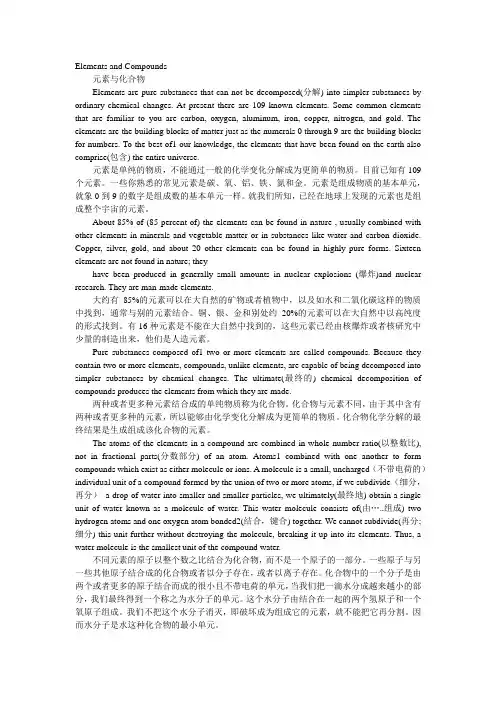
Elements and Compounds元素与化合物Elements are pure substances that can not be decomposed(分解) into simpler substances by ordinary chemical changes. At present there are 109 known elements. Some common elements that are familiar to you are carbon, oxygen, aluminum, iron, copper, nitrogen, and gold. The elements are the building blocks of matter just as the numerals 0 through 9 are the building blocks for numbers. To the best of1 our knowledge, the elements that have been found on the earth also comprise(包含) the entire universe.元素是单纯的物质,不能通过一般的化学变化分解成为更简单的物质。
目前已知有109个元素。
一些你熟悉的常见元素是碳、氧、铝、铁、氮和金。
元素是组成物质的基本单元,就象0到9的数字是组成数的基本单元一样。
就我们所知,已经在地球上发现的元素也是组成整个宇宙的元素。
About 85% of (85 percent of) the elements can be found in nature , usually combined with other elements in minerals and vegetable matter or in substances like water and carbon dioxide. Copper, silver, gold, and about 20 other elements can be found in highly pure forms. Sixteen elements are not found in nature; theyhave been produced in generally small amounts in nuclear explosions (爆炸)and nuclear research. They are man-made elements.大约有85%的元素可以在大自然的矿物或者植物中,以及如水和二氧化碳这样的物质中找到,通常与别的元素结合。
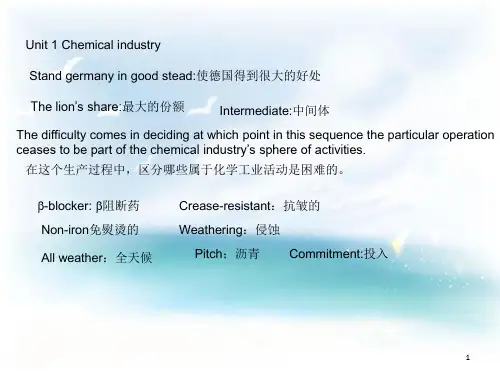
Lesson 1Chemical Engineering1、What is chemical engineering and its content?The Institution of Chemical Engineers defines chemical engineering as “that branch of engineering which is concerned with processes in which materials undergo a required change in composition, energy content or physical state: with the means of processing; with the resulting products, and with their application to useful ends”.2、What concept is the landmark in the development of chemical engineering?Unit operations3、What are the basic laws of chemical engineering science?The principles of chemistry, physics, and mathematics.The laws of physical chemical and physics govern the practicability and efficiency of chemical engineering operations. Energy changes, deriving from thermodynamics consideration, are particularly important. Mathematics is a basic tool in optimization and modeling.4、Name the functions and branches of chemical engineering you know.Chemical Engineering Functions: The design and development of both processes and plant items.Branches of Chemical Engineering: Plastics, polymers, synthetic fibers, dyeing, pulp and paper manufactures, pharmaceutical industry, and separation of rare metals.Lesson 2 Chemical Equilibrium and Kinetics1、Which factors influence the reaction rates?a)Temperatureb)concentrations of reactants (or partial pressure of gaseous reactants)c)presence of a catalyst.2、How to determine the reaction equilibrium constants?For a reversible reaction:aA + bB = cC +dDthe equilibrium constant expression is written as follows:K = C c D d / A a B bLesson 3 The Second Law of Thermodynamics1、What are the applications of chemical thermodynamics?There is two major applications of thermodynamics:( i ) The calculation of heat and work effect associated with processes as well as the calculation of the maximum work obtainable from a process or the minimum work required to drive a process.( ii ) The establishment of relationship among the variables describing systems at equilibrium.Lesson 4 Chemical Reaction Engineering1、Homogeneous Reactions vs. Heterogeneous ReactionsHomogeneous reactions are those in which the reactants, products, and any catalyst used form one continuous phase; gaseous and liquid.Heterogeneous reactions are those in which two or more phases exist, and the overriding problem in the reactor design is to promote mass transfer between the phases. The possible combinations of phase are:( i ) Liquid-liquid ( ii ) Liquid-solid ( iii ) Liquid-solid-gas( iv ) Gas-solid ( v ) Gas-liquid2、Reactor Geometry(type)Stirred Tank ReactorsTubular ReactorsPacked Bed ReactorsFluidized Bed ReactorsLesson 5 Chlor-Alkali and Related Processes1、What are the mechanisms of chlor-alkali process?The reaction are based on the idea of using electrons as a reagent in chemical reactions. The basic reactions of brine electrolysis can be written as follows:Anode 2Cl- - 2e-—> Cl2Cathode 2H2O + 2e-—> H2 + 2OH-The overall reaction is: 2Na+ + 2Cl- + 2H2O —> NaOH + Cl2 + H2Lesson 7 Momentum, Heat, and Mass Transfer1、In some cases, momentum , heat and mass transfer all occurs simultaneously, explain with examples.In a water-cooling tower, where transfer of sensible heat (heat transfer) and evaporation (mass transfer) both take place from the surface of the water droplets. Momentum transfer take place between the water droplets and air.2、What will happen for two adjacent layers of fluid with different moving velocities?There will be a tendency for the faster moving layer to be retarded and the slower moving layer to be accelerated by virtue of the continuous passage of molecules in each direction. There will be a net transfer of momentum from the fast to the slow moving stream.Lesson 10 Gas Absorption1、There are three ways in which a large contact area can be established:1. The liquid is brought in contact with the gas in the form of thin films ( film scrubbers).2. The liquid is dispersed in the gas in the form of minute drops (spray scrubbers).3. The gas is dispersed in the liquid in the form of small bubbles (bubble scrubbers). All apparatus applied in gas absorption practice is based on one of these three principles or on a combination of them.Lesson 13 Filtration1、Which factors should be considered in the operation of filtration?a)The properties of the liquid , particularly its viscosity, density and corrosive properties.b)The nature of the solid - its particle size and shape, size distribution, and packing characteristics.c)The concentration of solids in suspension.d)The quality of material to be handled, and its value.e)Whether the valuable product is the solid, the fluid, or both.f)Whether it is necessary to wash the filtered solids.g)Whether very slight contamination caused by contact of the suspension or filtrate with the various components of the equipment is detrimental to the product.h)Whether the feed liquor may be heated.i)Whether any form of pretreatment would be helpful.2、Which factors will have a close relation with the rate of filtration?a) The drop in pressure from the feed to the far side of the filter medium.b) The area of the filtering surface.c) The viscosity of the filtrate,d) The resistance of the filter cake.e) The resistance of the filter medium and initial layers of cake.Lesson 15 Computer-Assisted Design of New Process1、Design for new processed proceed through at least three stagesConceptual Design: the generation of ideas for new processes (processed synthesis) and their translation into an initial design. This stage includes preliminary cost estimates to asses the potential profitability of the process, as well as analyses of process safety andenvironmental considerations.Final Design: a rigorous set of design calculations to specify all the significance details of a process,Detailed Design: preparation of engineering drawing and equipment lists needed for construction.TBC ...Lesson 16 Catalysis1、Catalytic reactions can be classified into three types:The most common is heterogeneous catalysis, in which the catalyst is a solid and the reactants and products are either gases or liquids. The second type is homogeneous catalysis, in which the reactants, products and catalyst are molecularly dispersed in a single phase, usually the liquid phase. The third type is enzyme catalysis.Lesson 18 Polymers and Polymerization Techniques1、There are five general methods of polymerization:( i ) Bulk (or mass) ( ii ) Solution ( iii ) Slurry (or precipitation)( iv ) Suspension(or dispersion) ( v) EmulsionFurther lesser-used methods include:( vi ) Interfacial ( vii ) Reaction injection moulding (RIM)( viii ) Reactive processing of molten polymers2、A polymerization process consists of three stages:( i ) Monomer preparation ( ii ) Polymerization ( iii ) Polymer recover。
大学化工专业英语Lesson-1Chemical EngineeringChemical engineering is the development of processes and the design and operation of plants in which materials undergo changes in physical or chemical state on a technical scale.化学工程是过程的开发和工厂的设计与操作,在工厂中材料以某种技术规模进行的物理或化学状态的变化。
Applied throughout the process industries, it is founded on the principles of chemical, physics, and mathematics.它建立在化学、物理和数学的原则上,适用于整个流程工业。
The laws of physical chemistry and physics govern the practicability and efficiency of chemical engineering operations.物理化学和物理定律支配着化工业务的实用性和效率。
Energy changes, deriving from thermodynamic considerations, are particularly important.能量的变化,从热力学考虑派生,显得尤其重要。
Mathematics is a basic tool in optimization and modeling.数学是一个优化和建模的基本工具。
Optimization means arranging materials, facilities, and energy to yield as productive and economical an operation as possible.优化意味着合理安排材料、设备和能源,尽可能生产经济多产的操作。
unite 1. Inorganic chemistry1。
1 what is chemistry(1). 重点专业词汇讲解:Chemical: adj . 化学的、化学药品Transformation: 变化,化学转变,转化Dye: n。
染料染色,或者vt。
染Charcoal: [’tʃɑkəʊl] 木炭Cellulose :纤维素细胞的[’seljʊləʊz;]Fat:n. 脂肪肥肉adj 。
肥大的alkalis:碱adj 。
碱性的glycerin:甘油丙三醇alkalis: n。
碱金属alloy: 合金使成合金bronze:青铜色的n. 青铜(铜和锡的合金)brass:[brɑs]n。
黄铜(铜和锌)要求学生会区别黄铜及青铜的不同翻译Poison:毒物毒药t. 毒害放毒下毒Proton:n。
质子Nulei: n。
核(nucleus的复数形式)[’njuklɪəs]Identical : adj . 同一的Chirality n. 手性手征和Handeness的区别Amino acid :n。
氨基酸Alanine: n.丙氨酸2。
课文中重点词组(phrase)Chemical change: 化学变化physical change:物理变化Explore: 探险研究research investigate studyIsolate:分离chemical bonds 化学键chemical reaction:化学反应Natural substance 天然物质Coke :焦炭carbon monoxide 一氧化碳Carbon Dioxide 二氧化碳Chemical bond 化学键fundamental principle 基本原理The periodic table of elements :元素周期表numbers of protons 质子数atomic number 原子序数covalent bonds 共价键positive 正阳性negative 负阴性3. 课文中重点句子The first and most important principle is that chemical substances are made up of molecules in which atoms of various elements are linked in well-defined ways。
Chemical EngineeringChemical engineering is the development of processes and the design and operation of plants in which materials undergo changes in physical or chemical state on a technical scale.化学工程是过程的开发和工厂的设计与操作,在工厂中材料以某种技术规模进行的物理或化学状态的变化。
Applied throughout the process industries, it is founded on the principles of chemical, physics, and mathematics.它建立在化学、物理和数学的原则上,适用于整个流程工业。
The laws of physical chemistry and physics govern the practicability and efficiency of chemical engineering operations.物理化学和物理定律支配着化工业务的实用性和效率。
Energy changes, deriving from thermodynamic considerations, are particularly important.能量的变化,从热力学考虑派生,显得尤其重要。
Mathematics is a basic tool in optimization and modeling.数学是一个优化和建模的基本工具。
Optimization means arranging materials, facilities, and energy to yield as productive and economical an operation as possible.优化意味着合理安排材料、设备和能源,尽可能生产经济多产的操作。
Modeling is the construction of theoretical mathematical prototypes of complex process systems, commonly with the aid of computers.建模是将复杂过程系统建设出其理论数学原型的过程,通常需要借助电脑完成。
Chemical engineering is as old as the process industries.化学工程和过程工业一样古老。
Its heritage dates from the fermentation and evaporation processes operated by early civilizations.其遗产起源于早期文明的发酵和蒸发过程。
Modern chemical engineering emerged with the the development of large-scale, chemical-manufacturing operations in the second half of the 19th century.在19世纪下半叶,随着大规模的化学制造业操作的发展,现代化学工程出现了。
Throughout its development as an independent discipline, chemical engineering has been directed toward solving problems of designing and operating large plants for continuous production.化学工程作为一门独立的学科,纵观其发展过程,它已经朝向解决设计问题和经营连续生产的大型工厂的问题。
Manufacture of chemicals in the mid-19th century consisted of modest craft operations.在19世纪中叶,化工生产由小型的手工操作组成。
Increase in demand, public concern at the emission of noxious effluents, and competition between rival processes provided the incentives for greater efficiency.需求的增加,公众对有害物质排放的关注,和与对手的竞争过程为创造更高效率提供了激励机制。
This led to the emergence of combines with resources for larger operations and caused the transition from a craft to a science-based industry.这导致了更大的操作与资源相结合的联合工厂的出现,引起了从手工业到一个以科学为基础的产业(科技工厂)的过渡。
The result was a demand for chemists with knowledge of manufacturing processes, known as industrial chemists or chemical technologists.其结果是应了具有制作过程知识的化学家的要求,这是为工业化学家或化工技师所知晓的The term chemical engineer was in general use by about 1900.化学工程师一词广泛应用了约1900年。
Despite its emergence in traditional chemicals manufacturing, it was through its role in the development of the petroleum industry that chemical engineering became firmly established as a unique discipline.尽管出现在传统的化学品制造中,但它的价值却是通过其在石油工业——这门由化工工程牢固建立成的独立学科来实现的。
The demand for plants capable of operating physical separation processes continuously at high levels of efficiency was a challenge that could not be met by the traditional chemist or mechanical engineer.工厂的需求是能够高效连续地进行物理分离过程的操作,这是传统的化学家或工程师无法迎接的挑战。
A landmark in the development of chemical engineering was the publication in 1901 of the first textbook on the subject, by George E. Davis, a British chemical consultant. 化学工程发展的一个里程碑是1901年,一个英国化学顾问乔治·E·戴维斯出版的关于此话题的教科书。
This concentrated on the design of plant items for specific operations.这本书集中描述了设计工厂项目的具体操作。
The notion of a processing plant encompassing a number of operations, such as mixing, evaporation, and filtration, and of these operations being essentially similar, whatever the product, led to the concept of unit operations.注意到加工厂包括的一系列操作,如混合、蒸发、过滤,无论产物是什么,这些操作都基本相同,从而导致了单元操作的概念。
This was first enunciated by the American chemical engineer Arthur D. Little in 1915 and formed the basis for a classification of chemical engineering that dominated the subject for the next 40 years.这被美国化学工程师理特于1915年首次解释,形成了化学工程分类的基础,主导了未来40年的主题。
The number of unit operations—the building blocks of a chemical plant—is not large. 单元操作的数目——一个化工厂的建设模块数并不大。
The complexity arises from the variety of conditions under which the unit operations are conducted.复杂性来自于单元操作进行的条件的多样性。
In the same way that a complex plant can be divided into basic unit operations, so chemical reactions involved in the process industries can be classified into certain groups, or unit processes(e.g., polymerizations, esterifications, and nitrations), having common characteristics.同复杂的工厂可划分为基本的单元操作一样,过程工业中涉及到的化学反应也可分成一定的单元过程(如聚合、酯化和硝化),它们具有共同的特性。
This classification into unit processes brought rationalization to the study of process engineering.单元过程的这种分类对于过程工程的研究是合理的。